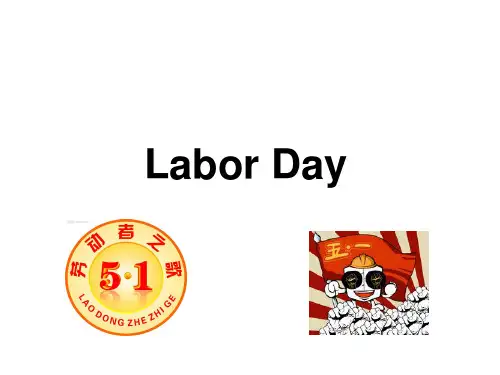牛津上海版英语九年级下册Unit3 Going Places
- 格式:ppt
- 大小:2.81 MB
- 文档页数:34
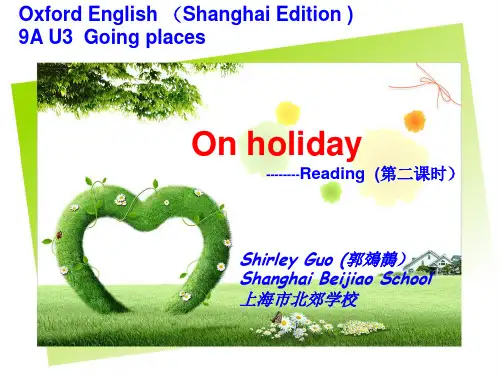
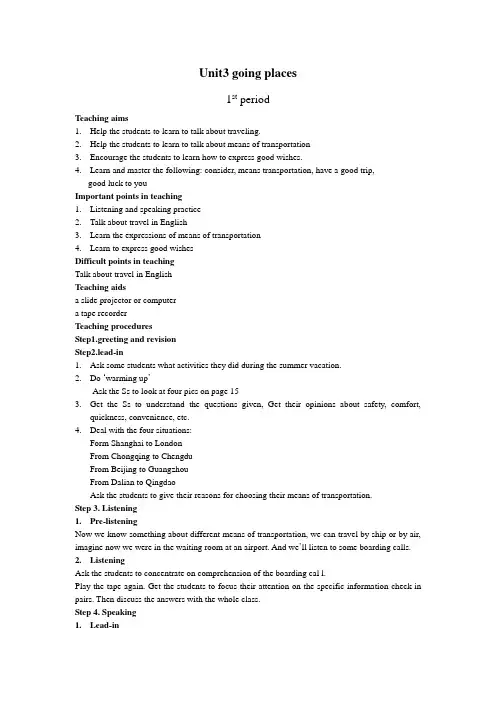
Unit3 going places1st periodTeaching aims1.Help the students to learn to talk about traveling.2.Help the students to learn to talk about means of transportation3.Encourage the students to learn how to express good wishes.4.Learn and master the following: consider, means transportation, have a good trip,good luck to youImportant points in teaching1.Listening and speaking practice2.Talk about travel in English3.Learn the expressions of means of transportation4.Learn to express good wishesDifficult points in teachingTalk about travel in EnglishTeaching aidsa slide projector or computera tape recorderTeaching proceduresStep1.greeting and revisionStep2.lead-in1.Ask some students what activities they did during the summer vacation.2.Do …warming up‟Ask the Ss to look at four pics on page 153.Get the Ss to understand the questions given, Get their opinions about safety, comfort,quickness, convenience, etc.4.Deal with the four situations:Form Shanghai to LondonFrom Chongqing to ChengduFrom Beijing to GuangzhouFrom Dalian to QingdaoAsk the students to give their reasons for choosing their means of transportation.Step 3. Listening1.Pre-listeningNow we know something about different means of transportation, we can travel by ship or by air, imagine now we were in the waiting room at an airport. And we‟ll listen to some boarding calls. 2.ListeningAsk the students to concentrate on comprehension of the boarding cal l.Play the tape again. Get the students to focus their attention on the specific information check in pairs. Then discuss the answers with the whole class.Step 4. Speaking1.Lead-inTalk to the students about their travel experiences in the past. Questions:Where did you travel?When did you do that?How did you travel?2.Deal with the tableAsk three or more students about the year and the place they want to travel to ask one to write the information on the form on the blackboard, and the others in the form on page 16.3.Do the exampleDemonstrate the example with a good student.Then ask the students to make a dialogue with their partners on pairs according to the completed form.4.Consolidation practice(1)Ask the students to create their own dialogues according to their own imagination of travelingto the past or the future in different machines.(2)Show the traveling of a spaceship in space and ask the students to make a dialogue aboutit. .Step 5 SummarySum up what has been taught and what they have learned in this part.Step 6 Assignment1.Revise the contents of this class2.Get ready to act out a dialogue about traveling2nd periodTeaching aims1.Words and expressions:Experience, simply, get away from, vacation, nature, basic, equipment, tip cell, phone, watch out, poison, poisonous, paddle, stream, normal, excitement, adventurous, handle, similarity. 2.Improve the students‟ reading comprehension.Important Points in TeachingTrain the students to improve their reading comprehensionDifficult Points in Teaching1.Question and Answer for inducing2.Fast reading to find out some general information3.Careful reading to find out the details in the passages4.Pair-work/ Group-work activitiesTeaching Aids1.A tape recorder2. A slide projectorMain Procedures in TeachingStep1 Greeting and Revision as usualStep 2 Pre-ReadingLead-inDo you like traveling?Why do you like traveling? And why not?Where would you most like to travel? Why is that?Have you ever tried any adventure travel in your life?Please discuss these questions with your partner.Step 3 While-reading1.Fast readingWhat‟s the basic equipment you need for hiking?2.more question sWhere can you go hiking?How can you go hiking?Why is hiking a great way to travel?What do you think of hiking?3.Do the same with RAFTINGWhere can you go rafting?How can you do that?Why is rafting another exciting adventure?What do you think of a normal rafting trip?What‟s your opinion about whitewater rafting?Why is rafting a good way to experience nature?What is it like when you go on a normal rafting trip?What is it like when you go on a white-water rafting trip?Can you think of some other words like “whitewater”?Step 4 Post-reading1.Ask the students to choose their answers for the questions according to the passages.2.Ask them to check in pairs.3.Check the answers with the whole class.4.Ask the students to fill in the table individually.5.Check with the whole class.Step 5 ConsolidationTell me about hiking/rafting.Step 6 Play the record of the first paragraph for each passage for the students to listen and follow. Ask them to pay attention to the pronunciation and intonation.Step 7 Summary1.Help the students to compare/contrast hiking and rafting to have a clear picture of theirsimilarities and differences.2.Help the students to make a list of useful words. Expressions and patterns in the passages. Step 8 AssignmentRevise the contents of the passages.Outline the two passages.3rd period。
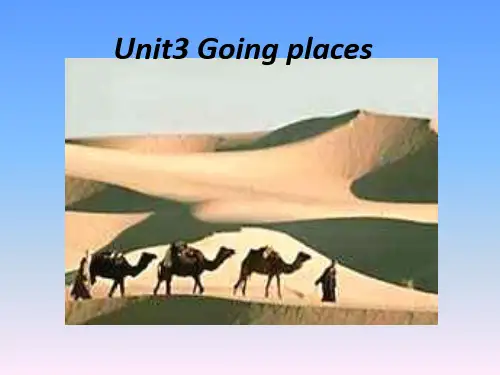
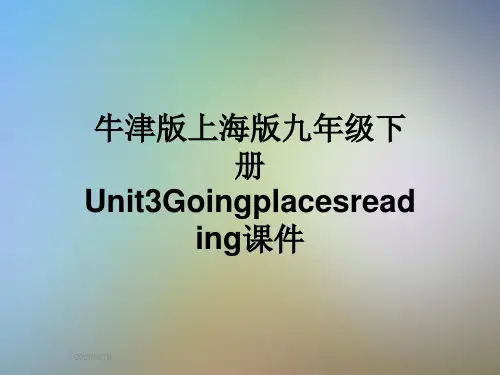
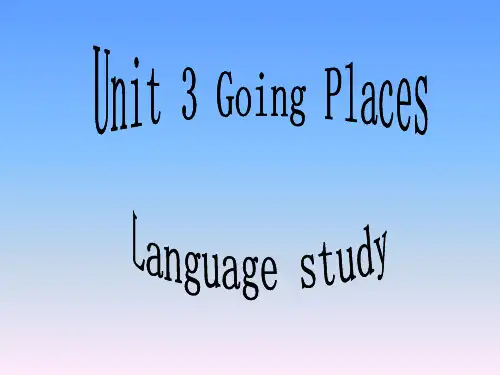
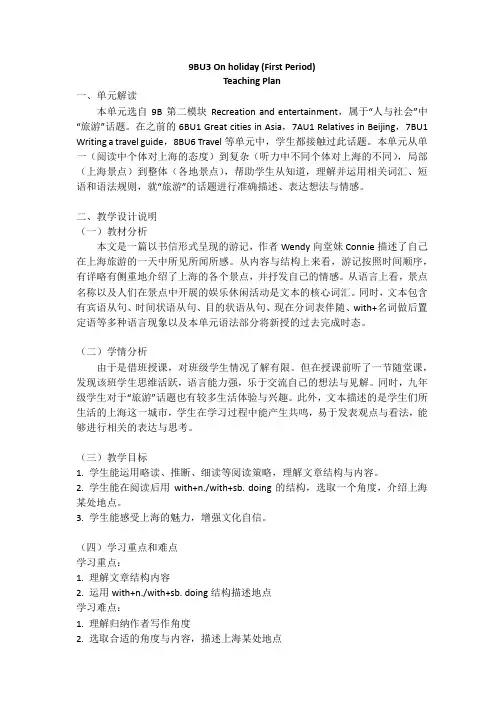
9BU3 On holiday (First Period)Teaching Plan一、单元解读本单元选自9B第二模块Recreation and entertainment,属于“人与社会”中“旅游”话题。
在之前的6BU1 Great cities in Asia,7AU1 Relatives in Beijing,7BU1 Writing a travel guide,8BU6 Travel等单元中,学生都接触过此话题。
本单元从单一(阅读中个体对上海的态度)到复杂(听力中不同个体对上海的不同),局部(上海景点)到整体(各地景点),帮助学生从知道,理解并运用相关词汇、短语和语法规则,就“旅游”的话题进行准确描述、表达想法与情感。
二、教学设计说明(一)教材分析本文是一篇以书信形式呈现的游记,作者Wendy向堂妹Connie描述了自己在上海旅游的一天中所见所闻所感。
从内容与结构上来看,游记按照时间顺序,有详略有侧重地介绍了上海的各个景点,并抒发自己的情感。
从语言上看,景点名称以及人们在景点中开展的娱乐休闲活动是文本的核心词汇。
同时,文本包含有宾语从句、时间状语从句、目的状语从句、现在分词表伴随、with+名词做后置定语等多种语言现象以及本单元语法部分将新授的过去完成时态。
(二)学情分析由于是借班授课,对班级学生情况了解有限。
但在授课前听了一节随堂课,发现该班学生思维活跃,语言能力强,乐于交流自己的想法与见解。
同时,九年级学生对于“旅游”话题也有较多生活体验与兴趣。
此外,文本描述的是学生们所生活的上海这一城市,学生在学习过程中能产生共鸣,易于发表观点与看法,能够进行相关的表达与思考。
(三)教学目标1. 学生能运用略读、推断、细读等阅读策略,理解文章结构与内容。
2. 学生能在阅读后用with+n./with+sb. doing的结构,选取一个角度,介绍上海某处地点。
3. 学生能感受上海的魅力,增强文化自信。
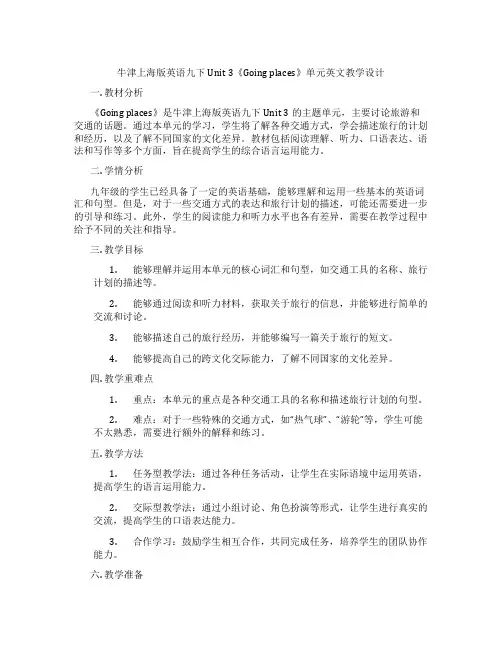
牛津上海版英语九下Unit 3《Going places》单元英文教学设计一. 教材分析《Going places》是牛津上海版英语九下Unit 3的主题单元,主要讨论旅游和交通的话题。
通过本单元的学习,学生将了解各种交通方式,学会描述旅行的计划和经历,以及了解不同国家的文化差异。
教材包括阅读理解、听力、口语表达、语法和写作等多个方面,旨在提高学生的综合语言运用能力。
二. 学情分析九年级的学生已经具备了一定的英语基础,能够理解和运用一些基本的英语词汇和句型。
但是,对于一些交通方式的表达和旅行计划的描述,可能还需要进一步的引导和练习。
此外,学生的阅读能力和听力水平也各有差异,需要在教学过程中给予不同的关注和指导。
三. 教学目标1.能够理解并运用本单元的核心词汇和句型,如交通工具的名称、旅行计划的描述等。
2.能够通过阅读和听力材料,获取关于旅行的信息,并能够进行简单的交流和讨论。
3.能够描述自己的旅行经历,并能够编写一篇关于旅行的短文。
4.能够提高自己的跨文化交际能力,了解不同国家的文化差异。
四. 教学重难点1.重点:本单元的重点是各种交通工具的名称和描述旅行计划的句型。
2.难点:对于一些特殊的交通方式,如“热气球”、“游轮”等,学生可能不太熟悉,需要进行额外的解释和练习。
五. 教学方法1.任务型教学法:通过各种任务活动,让学生在实际语境中运用英语,提高学生的语言运用能力。
2.交际型教学法:通过小组讨论、角色扮演等形式,让学生进行真实的交流,提高学生的口语表达能力。
3.合作学习:鼓励学生相互合作,共同完成任务,培养学生的团队协作能力。
六. 教学准备1.教师准备PPT,包括本单元的核心词汇和句型,以及相关的阅读和听力材料。
2.准备一些关于旅行的图片和视频,用于激发学生的兴趣和想象力。
3.准备一些旅行计划的小卡片,用于课堂操练和巩固环节。
七. 教学过程1.导入(5分钟):教师通过展示一些关于旅行的图片和视频,引导学生谈论自己的旅行经历,激发学生的兴趣和想象力。

Going places教学目标1、To make students know more about Shanghai2、To practice describing the procedure of a visit3、To have a general idea about Wendy’s letter2学情分析本单元的中心话题是“旅游”,这是一个时尚话题,大部分学生也应该具有不少的旅游经历,而本节课又是关于国外友人参观上海的内容,学生应该对上海相当熟悉,有丰盛的内容可以表达,所以本节课所有的语言知识和语言技能可以都是围饶这一中心话题而设计。
3重点难点1、To know how to describe a place properly.2、To have a report about Wendy’s letter.4教学过程4.1第一学时4.1.1教学活动活动1【活动】Pre–taskStudents listen to a piece of music while enjoying some pictures.Ask students: What do the music and the pictures make you think of?3、Talk about holidaysWhat do you usually do on holiday?How do you go to different places?Ask students to raise some questions about my visit to Beijing.5、Introduce how to write an article about visiting places.活动2【讲授】While-task1、Name some tourist attractions in Shanghai2、ThinkWhy do tourists come to Shanghai? List some reasons.3、A quizHow much do you know about Shanghai?4、Look at the title, the pictures and the first 3 lines and the last 5 lines ofthe letter. Then answerthe questions.5、What do you want to know about her holiday?6、Match the places with the possible description.7、Write the number of visiting order for Wendy.8、Report Wendy’s holiday to class in brief.活动3【活动】Post-taskAskthestudengtstocreate theirowndialoguesaccordingtotheirownimaginationof travelling to the past or the future in diffierent machines.活动4【作业】AssignmentsAssignments:1、Read the text after the recording twice.2、UsetheinternettofindmoreinformationaboutinterestingplacesinChinaandmake a plan for your May Day第二学时4.1.1教学活动活动1【活动】OnholidayStagesTeacher’sactivitiesStudents’activitiesPurposesI. Pre-task preparationsAsk Ss to play the game“Bingo”Guessing game of wordsTo review the different new words and phrases and get warmed upII. While-task procedure1. Review students the new words and phrases with the help of phonetic symbolsAsk Ss to read the new words and the patternRead the new words and phrases.Have a dictation.To consolidate the new words and phrases.2. Play the recording of the text, ask Ss to answer the questions according to thetextListen to the text, answer the questionsTo listen for specific information from the text, and get information .3. Ask Ss to read the text after the tapeRead the textTo practise the new-learnt text4.ProvideSswiththepicturesandahypothesizedsituationtotalkabouttheTrojanWar .Use the extension words to practise whatthey learnedTo practise the structuresIII. Post-task activitiesAsk Ss to retell the story in their own words.(group work)Retell the story in their own wordsTo use the new words and patterns fluently in a real situationIV. AssignmentRead the text again and again after class.Retail the text in your own words.Do the exercises on page 40 and 41.。
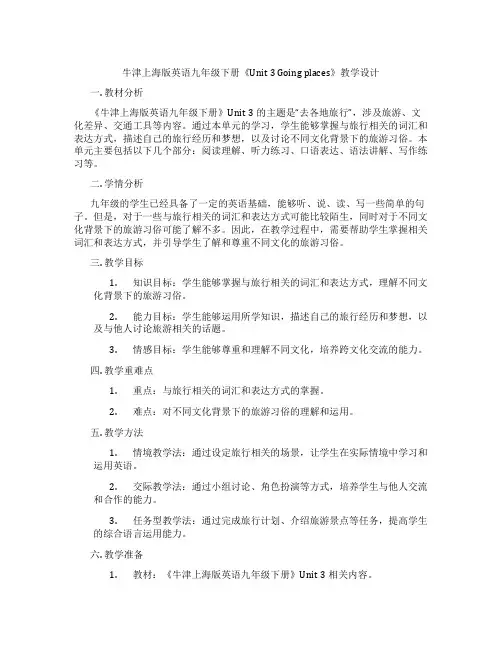
牛津上海版英语九年级下册《Unit 3 Going places》教学设计一. 教材分析《牛津上海版英语九年级下册》Unit 3的主题是“去各地旅行”,涉及旅游、文化差异、交通工具等内容。
通过本单元的学习,学生能够掌握与旅行相关的词汇和表达方式,描述自己的旅行经历和梦想,以及讨论不同文化背景下的旅游习俗。
本单元主要包括以下几个部分:阅读理解、听力练习、口语表达、语法讲解、写作练习等。
二. 学情分析九年级的学生已经具备了一定的英语基础,能够听、说、读、写一些简单的句子。
但是,对于一些与旅行相关的词汇和表达方式可能比较陌生,同时对于不同文化背景下的旅游习俗可能了解不多。
因此,在教学过程中,需要帮助学生掌握相关词汇和表达方式,并引导学生了解和尊重不同文化的旅游习俗。
三. 教学目标1.知识目标:学生能够掌握与旅行相关的词汇和表达方式,理解不同文化背景下的旅游习俗。
2.能力目标:学生能够运用所学知识,描述自己的旅行经历和梦想,以及与他人讨论旅游相关的话题。
3.情感目标:学生能够尊重和理解不同文化,培养跨文化交流的能力。
四. 教学重难点1.重点:与旅行相关的词汇和表达方式的掌握。
2.难点:对不同文化背景下的旅游习俗的理解和运用。
五. 教学方法1.情境教学法:通过设定旅行相关的场景,让学生在实际情境中学习和运用英语。
2.交际教学法:通过小组讨论、角色扮演等方式,培养学生与他人交流和合作的能力。
3.任务型教学法:通过完成旅行计划、介绍旅游景点等任务,提高学生的综合语言运用能力。
六. 教学准备1.教材:《牛津上海版英语九年级下册》Unit 3相关内容。
2.多媒体教学设备:用于展示图片、视频等教学资源。
3.教学资源:与旅行相关的图片、视频、文章等。
七. 教学过程1.导入(5分钟)利用多媒体展示不同国家的旅游景点,引导学生谈论自己最喜欢的旅游目的地,激发学生的学习兴趣。
2.呈现(10分钟)展示本节课的主题“Going Places”,引导学生学习与旅行相关的词汇和表达方式。
